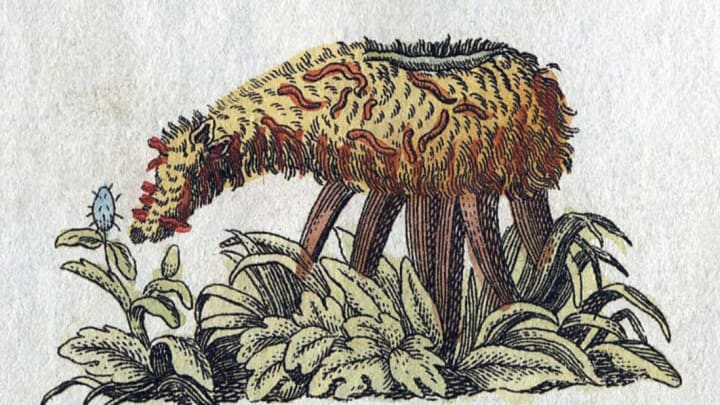In the Middle Ages, travelers brought home tales from all over the globe of wondrous and fantastic plants and beasts—but many of these travelers were just relaying stories they’d heard instead of things they’d actually seen. These stories, in turn, were written about by educated men who’d never traveled. And they were illustrated by artists who only had hearsay to go by. It’s no wonder they were completely misunderstood.
1. WAQ WAQ TREE

Bodleian Libraries via Wikimedia Commons // CC BY 4.0
According to legend, the Waq Waq Tree, which bears human or animal fruit, grows on an island in the Indian Ocean or China Sea. In some of these stories, the fruit begins as human heads that grow into entire bodies, while in others the fruit begins as human babies that mature. Either as the fruit grows, or when it falls, it cries “Waq waq!” There's a possibility that the Waq Waq tree might have been a reference to coconut trees, which has fruit that kind of looks like a human head. The tree began appearing in Islamic art in the 12th and 13th centuries.
2. JINMENJU

Toriyama Sekien via Wikimedia Commons // Public Domain
The Jinmenju is a tree similar to the Waq Waq, but the story originates from China and was passed to Japan. According to the legend, the tree produces fruit that has the face of a human child. These faces don’t speak, but they smile and laugh all the time. If they laugh too exuberantly, they fall to the ground. The fruit is both sweet and sour, and the seeds inside also resemble human faces.
3. BARNACLE TREE

Unknown via Wikimedia Commons //Public Domain
The legend of the Barnacle Tree, or Goose Tree, involves two animals and a plant, and it was an attempt to explain several odd phenomena that were observed but misunderstood. In the Middle Ages, people saw black and white geese in Ireland and Scotland in the wintertime, but in the spring, the animals disappeared. No one saw them nest or reproduce, and yet there they were, every winter. (The animals, of course, had migrated and nested elsewhere, but people didn't know about that behavior at the time.) However, small barnacles were seen clinging to driftwood that had white shells and black stalks that looked like the goose—so people came to believe that a tree produced the barnacles as fruit, which grew into the geese. Those barnacles are now known as goose barnacles (Lepas anserifera), and the geese are known as barnacle geese (Branta leucopsis).
4. VEGETABLE LAMB

Unknown via Wikimedia Commons // Public Domain
The Vegetable Lamb of Tartary was a legendary plant that produced an animal, native to Central Asia and Europe. Given the names Tartarica barometz (Tartar lamb) and Agnus Scythicus (Scythian lamb), the “vegetable lamb” was described as a plant between 2.5 and 3 feet tall that bore a pod at the end of a stem. The pod eventually opened to reveal a lamb inside. The lamb remained attached to the rest of the plant by its stem, but could eat the vegetation around the plant, as far as the stem reached. Once all that was eaten (or if the stem somehow broke), the lamb would die.
There’s a specimen of the vegetable lamb at the Garden Museum in London. The small picture looks as if it could be a lamb, or an animal’s paw with long claws, or a part of a plant. Once samples were relayed to naturalists in the 17th century, though, it became clear that the “lamb” was part of a plant, and not an animal. The plant was eventually identified as Cibotium barometz, an evergreen fern that produces a hairy cover.
For misunderstood animals from this period, see 20 Bizarre Beasts From Ancient Bestiaries.
